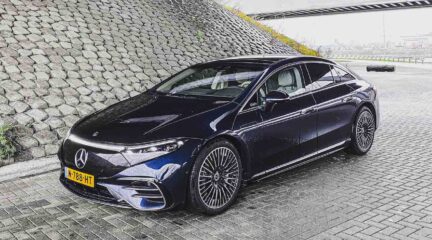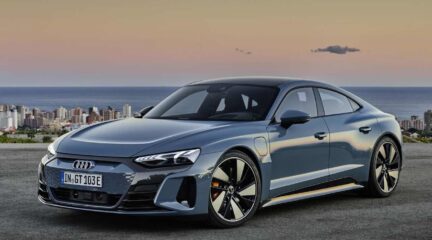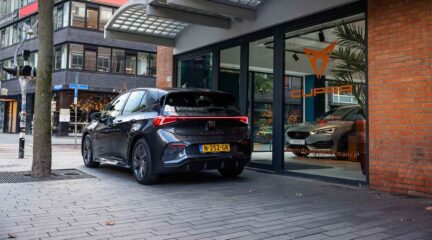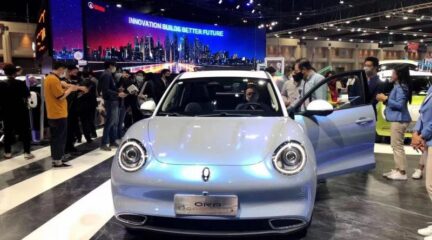
Het Italiaanse Pininfarina heeft vandaag bekend gemaakt dat ze samen met het Franse Bolloré een elektrische auto gaan produceren. De auto wordt gemaakt in Italië, en zal vanaf 2010 onder de naam Pininfarina verkocht worden in Europa, Amerika en Japan.
De twee bedrijven zullen allebei 150 miljoen investeren in een 50-50 joint venture. Het doel is om in eerste instantie 15.000 units per jaar te produceren.
De auto wordt een elektrische vierzitter en zal in de stad een actieradius hebben van 250 km. Dat is zowel qua aantal personen als qua range een stuk meer als die andere Europese elektro-auto. Het Noorse TH!NK is namelijk al een tijdje bezig met de ontwikkeling van een compact wagentje op stroom, onlangs maakte het bedrijf bekend te gaan samenwerken met Tesla en eind vorige maand is de productie van start gegaan.
[ bovenstaande afbeelding is van de Hafei HF Fantasy Pininfarina Concept uit 2002 ]
Bolloré and Pininfarina agreed to establish a 50-50 joint venture to manufacture a car that will be 100% electric. The car will be sold under the Pininfarina brand. The total investment is estimated at about 150 million euros. The electric car, which will be manufactured by Pininfarina in Italy, will benefit from the vast expertise gained by Pininfarina in the design and production of top-of-the-range automobiles and will be equipped with a revolutionary Lithium Metal Polymer battery developed by the Bolloré Group.
Bolloré, a French Group founded in 1822, has revenues in excess of 6 billion euros and 32,000 employees worldwide. As a result of its diversification strategy, it has operations in industry and in the transportation and media sectors. The Bolloré Group has significant holdings in Havas, Aegis, Mediobanca and Vallourec. Building on the technologies it developed over 30 years as the world’s leading manufacturer of components for capacitors, it has now developed an innovative battery.
Founded in 1930, the Pininfarina Group is based in Italy and has more than 3,000 employees a facilities throughout the world. Today, it is a leading supplier of automotive services, offering carmakers creative solutions based on proprietary knowhow at every step of design, product and process engineering and of niche vehicle manufacturing. Its Italian plants can produce up to 60,000 cars a year (and up to 20,000 cars a year in its Sweden plant).
Because the car that Bolloré and Pininfarina plan to develop and manufacture jointly will be 100% electric, it will produce 0% carbon dioxide emissions. It will have four seats and will be equipped with a battery that will provide it with a range of 250 km in city driving. This battery, which is the product of 15 years of research, combines the benefit of high energy density with an exceptionally long life, enabling the vehicles it powers to run for more than 200,000 km.
The Lithium Metal Polymer technology is an all-solid technology. No liquid is required, which eliminates the danger of spills that could cause overheating or fires. The stability of the materials used contribute to the battery’s safety, with a battery combustion temperature above 200 degrees centigrade and no possibility of explosion. This technology, which was developed as a world exclusive by the Bolloré Group, has a critical advantage over the Lithium Ion technology. Moreover, each battery cell is protected electronically by passive and active systems that monitor on an ongoing basis its operating efficiency and the voltage and temperature of each element. The various cells are encased in a steel container that protects them from external agents.
Thanks to the battery’s large capacity, the Pininfarina electric car will have a very fast standing start (zero to 50 km/h in 4.9 seconds), sufficient acceleration to overtake other vehicles safely and a top speed of 130 km/h. It will also be fully automatic.
The battery can be recharged by plugging it into a standard home electrical outlet. A full charge will take about five hours, but a five-minute charge will be enough for a 25 km run. A number of roadside recharging electrical outlets already exist in some of the world’s major cities. As sales increase, more will be installed by city governments, service stations and parking facilities.
The Pininfarina electric car will be sold concurrently in Europe, the United States and Japan to start by 2010.
Production capacity, which will depend on the number of batteries that the Bolloré Group will be able to manufacture at its plants in Brittany (Ergué-Gaberic) and Canada (Montreal), should be sufficient to deliver up to 15,000 cars a year. Obviously, if markets requests exceed this limit, battery production will be increased.









Dit is dus niet die Sintesi?
In ’t (mat)zwart overspuiten, lichte bodykit eronder, kontje wat aanpassen en hij mag misschien op de weg. Anders doet ’t te zeer aan je ogen.
Het plaatje niet, maar wellicht is de Sintesi inderdaad een elektrische concept…
@Feanatieke: moeilijk he? lezen… het is een concept uit 2002.
Hopelijk is die sintesi dan wel wat mooier en minder frans :p
En de grote producenten durven…
Fantastisch! Een joint venture tussen een Frans en Italiaans bedrijf, moet wel een prachtauto worden!
hopelijk is dit de reddingsboei die pininfarina nodig heeft. ik zou het egt zonde vinden als een auto bedrijf als pininfarina dat zoveeel aan de auto historie heeft bijgedragen ten onder gaat door zoiets simpels als geld tekort.
This quote stops me and makes me wonder….
“(zero to 50 km/h in 4.9 seconds),”
Als we met dit soort cijfers gaan pochen, zijn we dan niet een beetje terug bij af? Worden we niet een jaartje of 30 terug in de tijd gegooid?
En waar we nu zeggen, ik heb een gaziljon PK´s under the hood, gaan we later dan opscheppen over kW´s?
Rick dos
Komt goed maak je geen zorgen! De electro auto zal ook niet de uitkomst zijn, slechts een tijdelijke oplossing. Times change…
Het verhaaltje klopt niet helemaal: ”Het doel is om in eerste instantie 15.000 units per jaar te produceren.” In het persbericht staat niets over een doelstelling over het aantal te produceren auto’s, alleen dat er capaciteit is om 15.000 battery packs te produceren.
Of dat er daadwerkelijk van komt, zal wel afhangen van de prijs. Helaas zijn de ervaringen wat dat betreft in Europa slecht. Die Franse elektrische auto – naam ben ik even kwijt – kost 250.000 euro. Zet dat eens af tegen de 100.000 dollar (70.000 euro) voor de Tesla Roadster, die ook nog eens in alle opzichten superieur is.
Die koplampen zien er wel goed uit! :D Laat maar komen die bak.
Ja, 0 tot 50 in 5 seconden is toch enorm langzaam, dan heb je toch veel meer dan 10 seconden nodig tot 100? Beetje vreemd dat ze daarmee pochen…
150 miljoen aanbetaling voor een onbekende Franse auto producent?
Ben benieuwd!
@Rick Dos: Waren de pk’s niet allang vervangen door kilowatts :-)? Conservatief volk toch, die autoliefhebbers.
Hmmz, moet dit ze redden? Ik dacht het niet, elektrisch aangedreven wagens zijn nu al achterhaald en zullen het nooit maken. Dit is een hoop weggesmeten geld, kom aub met iets af waar mensen wel geïnteresseerd in zijn en wat wel mooi is. Ze konden het vroeger, dus nu moet dat ook kunnen.
Als hij er maar niet zo uitziet als het concept op plaatje
Ik ben geen fan ervan. Ik quote graag de beginalinea van een ander artikel:
“De naam Pininfarina associeer ik altijd met stijlvolle dure designs, zonder dat ik dan direct aan één specifiek model moet denken. De naam, die overigens al 77 jaar bestaat, klinkt op zichzelf al ontzettend chique. Wat een stuk minder chique is, is dat het designhuis al een aantal jaren achter elkaar verlies maakt en zich dit jaar opnieuw opmaakt voor een behoorlijk donkerrood banksaldo.”
Hier ben ik het compleet mee eens, en om dan een bereikbare (1) en elektrische (2) auto te bouwen?! Ik vind het niet bij Pininfarina passen (hoewel: De Matrix wel dan?).
Eh, ik heb iets gemist geloof ik. Waarom is een elektrisch aangedreven auto opeens achterhaald?
De nieuwste generatie elektrische auto kan prima meten met de huidige generatie benzine en/of diesel auto’s. De ontwikkelingen gaan snel. Met de nieuwste generatie Lio-Ion accu’s en krachtige elektromotoren kunnen deze elektrische wagens eenvoudig mee in het huidige verkeer, hebben ze voldoende bereik voor het dagelijkse werkverkeer en zijn ze al sneller dan hun fossiele broertjes.
Een mooi overzicht van de nieuwste elektrische auto’s is te vinden op de OliNo website:
http://www.olino.org/articles/2007/12/13/overzicht-elektrische-personen-autos